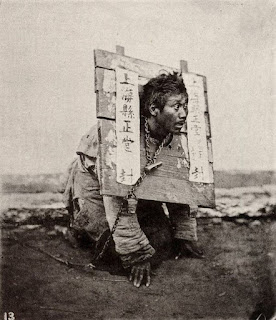This is a pillory as it was used in China, in the 19th century–history and facts
This is a pillory as it was used in China, in the 19th century.
This picture was taken in Shanghai, circa 1870.
It saved costs for prisons and was quite effective.
It doesn't look so terrible at first sight.
But you have to realize that this man can't reach his face with his hand.
So he can't eat.
He's in public and he's depending on people to take pity on him and feed him and water him like a dog.
But if they spit at him or - actually worse - threw sand in his eyes, he could not remove it.
Such a pillory was put around an offender for days, but also weeks, months, up to a year.
The torn open eyes of the man show his fear and psychological distress, which torment him without ceasing.
For even in a dungeon a man probably has moment of rest.
But a person who crawls through a city like this, can't even sleep quietly for a few hours.
It is without directly inflicting physical pain on someone , almost the worst imaginable.


.jpg)

.jpeg)






Comments
Post a Comment